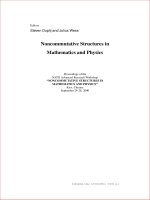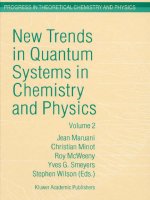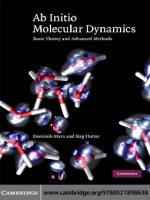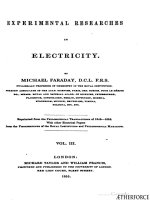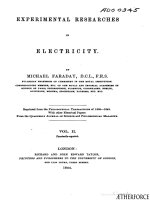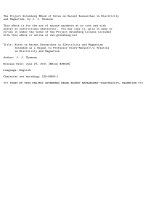Experimental researches in chemistry and physics
Bạn đang xem bản rút gọn của tài liệu. Xem và tải ngay bản đầy đủ của tài liệu tại đây (2.2 MB, 365 trang )
www.pdfgrip.com
Experimental Researches in Chemistry
and Physics
www.pdfgrip.com
www.pdfgrip.com
Experimental Researches in
Chemistry and Physics
MICHAEL FARADAY
Taylor & Francis
London • New York • Philadelphia
1991
www.pdfgrip.com
This edition published in the Taylor & Francis e-Library, 2005.
“To purchase your own copy of this or any of Taylor & Francis or
Routledges’s
collection of thousands of eBooks please go to
www.eBookstore.tandf.co.uk.”
UK Taylor & Francis Ltd, 4 John St., London WC1N 2ET
USA Taylor & Francis Inc., 1900 Frost Road, Suite 101, Bristol PA 19007
Foreword © J.M.Thomas 1991
All rights reserved. No part of this publication may be reproduced, stored in a retrieval system, or
transmitted, in any form or by any means, electronic, electrostatic, magnetic tape, mechanical,
photocopying, recording or otherwise, without the prior permission of the copyright owner and
publishers.
British Library Cataloguing in Publication Data Faraday, Michael 1791–1867 Experimental
researches in chemistry and physics. 1. Physical sciences I.Title 500.2
ISBN 0-203-21069-7 Master e-book ISBN
ISBN 0-203-26839-3 (Adobe e-Reader Format)
ISBN 0-85066-841-7 (Print Edition)
Library of Congress Cataloging-in-Publication Data Faraday, Michael, 1791–1867.
Experimental researches in chemistry and physics/Michael Faraday; with a foreword by
J.M.Thomas. p. cm. Originally published in 1859. Includes index. ISBN 0-85066-841-7 1.
Physics—Experiments—History. 2. Chemistry—Experiments —History. I. Title. QC33.F23 1991
530 72–dc20 90–41828 CIP
www.pdfgrip.com
EXPERIMENTAL RESEARCHES IN CHEMISTRY AND PHYSICS.
BY
MICHAEL FARADAY, D.C.L., F.R.S.,
FULLERIAN PROFESSOR OF
CHEMISTRY IN THE ROYAL INSTITUTION OF GREAT BRITAIN. HON. MEM.
R.S.ED., CAMB. PHIL., AND MED. CHIRURG. SOCC., F.G.S., ORD. BORUSSI
“POUR LE MÊRITE” EQ., COMMANDER OF THE LEGION OF HONOUR, INSTIT.
IMP. (ACAD. SC.) PARIS. SOCIUS, ACADD. IMP. SC. VINDOB. ET PETROP.,
REG. SC. BEROL.,
TAURIN., HOLM., MONAC., NEAPOL., AMSTELOD.,
BRUXELL., BONON., ITAL. MUT., SOCC. REG. GOTTING., ET HAFN., UPSAL.,
HARLEM. ACAD. AMER. BOST., ET SOC. AMER, PHILAD. SOCIUS, ACAD.
PANORM., SOCC. GEORG.
FLORENT., ET PHILOM. PARIS., INSTIT.
WASHINGTON., ET ACAD. IMP. MED. PARIS. CORRESP., ETC.
REPRINTED FROM THE PHILOSOPHICAL TRANSACTIONS OF 1821–1857;
THE JOURNAL OF THE ROYAL INSTITUTION; THE PHILOSOPHICAL
MAGAZINE, AND OTHER PUBLICATIONS.
LONDON: RICHARD TAYLOR AND WILLIAM FRANCIS, PRINTERS AND
PUBLISHERS TO THE UNIVERSITY OF LONDON, RED LION COURT, FLEET
STREET. 1859.
PRINTED BY TAYLOR AND FRANCIS,
RED LION COURT, FLEET STREET.
www.pdfgrip.com
CONTENTS.
Foreword
viii
Preface
xiv
EXPERIMENTAL RESEARCHES IN CHEMISTRY AND PHYSICS
INDEX
1
342
www.pdfgrip.com
www.pdfgrip.com
Foreword
to Bicentennial (1991) Edition
by
Professor J.M.Thomas, F.R.S.,
Fullerian Professor of Chemistry and Director of The
Royal Institution
Michael Faraday was incontestably one of the greatest experimental philosophers of all
time, a figure that still bestrides the world of chemistry and physics like a Colossus. But
in addition to his genius as a scientist, he also possessed numerous other qualities which
have endeared him to succeeding generations: warm humanity, genuine humility and
piety and a poetic ability to express, in beautifully evocative terms, his love of natural
phenomena. ‘Nothing is too wonderful to be true, if it be consistent with the laws of
nature and, in such things as these, experiment is the best test of such consistency’. ‘Let
us now consider how wonderfully we stand upon this world. Here it is we are born, bred,
and live, and yet we view these things with an almost entire absence of wonder.’
From his early days as an assistant bookbinder to his final years, when he had become
one of the world’s most famous scientists, he never ceased to be struck by a sense of awe
in contemplating the inner quality of things. Faraday was endowed both with an
irrepressible urge to write and a memorable way of communicating his thoughts. In his
youth he kept a ‘common place book’ or notebook in which he jotted down ideas, facts,
quotations and questions as they occurred to him. The earliest one has the following
description on the first page: ‘A collection of Notices, Occurrences, Events, etc., relating
to the Arts and Sciences collected from the Public Papers, Reviews, Magazines, and other
miscellaneous works. Intended to promote both Amusement and Instruction and also to
corroborate or invalidate those theories which are continually starting in the world of
science’. Posterity is indeed fortunate that this unique scholar and discoverer has
bequeathed a gigantic store of recorded contributions which, more than a century after his
death, continues to reward the historian of science, to kindle the hearts of the young and
to inspire aspiring and mature research scientists alike.
Even if the corpus of Faraday’s legacy of written material were only a fraction of what
it is, the story of his achievements, and the manner in which they were accomplished,
www.pdfgrip.com
bears repetition. His rise from the village blacksmith’s son to his role, first as a chemical
assistant to Humphry Davy at the Royal Institution—with his remarkable assimilation of
skills as an experimentalist that was soon to make him the premier analytical chemist of
his age—through to his election as Fellow of the Royal Society and his appointment as
the Fullerian Professor of Chemistry at the Royal Institution, is one of the most romantic
in the annals of science. He commenced his duties with Davy in March 1813. In October
of that year Faraday accompanied Davy and his wife on a prolonged tour of Europe that
brought him into contact with Ampère, Cuvier, Humboldt, Gay Lussac, Arago and Volta.
When he returned to England in April 1815 his education as an experimental philosopher
had advanced enormously and he had also become versed in French and Italian.
Largely because of their immediacy in the world of technology, and also because of
their unification and extension by Clerk Maxwell and Einstein, Faraday’s discoveries in
electricity and magnetism, encompassing as they do1 the suggestion of the ideas of a field
and lines of force and demonstrations of electromagnetic rotation (1821), electromagnetic
induction (1831), the identities of electricities from various sources (1832), electrostatics
and dielectrics (1835), discharge of gases (1835), light, electricity and magnetism (1845)
and diamagnetism (1845), tend to dwarf, at least in the minds of physicists, cosmologists
and engineers, his contributions to other branches of science. Yet he is also one of the
founders of chemistry. His pioneering work includes: the discovery and characterization
of the compounds of chlorine and carbon (1820), the introduction of photochemistry as a
preparative procedure (1821), the discovery of benzene (1825), researches on alloys and
steel (1818), the manufacture of optical quality glass (1825), the liquefaction of gases
(1823 and 1845), the laws of electrolysis (1833) and the introduction (with William
Whewell, the philosopher and polymathic Master of Trinity College Cambridge) of the
terms anode, cathode, ion etc. (1834).
In 1858 Faraday assembled his collected researches in chemistry and physics that had
appeared over the preceding forty years or so in Philosophical Transactions of the Royal
Society, The Journal of the Royal Institution, Philosophical Magazine and in other
publications. This collection is revealing both in what it does and does not include. His
first ever paper published in 1816, ‘On the Native Caustic Lime of Tuscany’ is
reproduced primarily for touching, personal reasons: Faraday records (p. 1), in a footnote
added in 1858, ‘It was the beginning of my communications to the public’; and it
represents his first attempt in chemistry ‘at a time when my fear was greater than my
confidence, and both far greater than my knowledge’. More important is his choice of the
whole of his (first) Bakerian lecture to the Royal Society—delivered in three instalments
in 1829—‘On the Manufacture of Glass for Optical Purpose’. Some historians of science
hold that Faraday’s researches on glass constitute a relatively barren period. True, he
spent a long time on them. But Faraday’s added footnote on p. 231 shows him to have
been proud of the crucial role his pioneering work on the preparation of glass played in
his own subsequent researches into diamagnetism and magneto-optics. The optical fibres
that now dominate the world of communications are generated by spinning molten glass
through small orifices in platinum-rich bushes, the very material which Faraday had so
painstakingly established as the most appropriate for the production of defect-free glass.
The reader is struck by Faraday’s versatility, originality, intellectual energy, the
enormous sweep of his brush and his limpid style. For the practitioner, the book is a goldmine strewn with glittering nuggets. Some of the experiments are ideally suited as class
www.pdfgrip.com
demonstrations for contemporary primary schoolchildren; others may be used, without
modification, as practical exercises for pre-university or college students; whilst yet
others identify themes that are currently at the frontier of modern chemical physics.
For example, Faraday’s account (p. 57) ‘On the Vapour of Mercury at common
Temperatures’ would appeal to enquiring young children even now. His summary of the
‘Composition of Crystals of Sulphate of Soda’ (p. 153) could be adopted, without
modification, for children in their mid-teens. For those interested in lecture
demonstrations, the description of the ‘Apparatus for the combustion of the Diamond’
(pp. 11–13) is archetypal; and details of the roaring flame given on p. 24 could readily be
adapted for a Christmas Lecture aimed at young audiences. The observation (p. 212) that
sulphur may remain liquid-like at room temperatures—well below its freezing point—ties
up with work recently reported2 at a Discussion meeting of the Royal Society of
Chemistry on the nature of the liquid—vapour interface of gallium monitored by
synchrotron radiation. The behaviour of the crystals formed when ‘a strong solution of
chloride of silver in ammonia was left for some weeks in a bottle stopped only by a piece
of paper’ (p. 19) is in line with modern theories of topochemistry3,4. And when Faraday
writes (p. 393)‘…at one time I hoped that I had altered one coloured ray (of light) into
another by means of gold…’ one is tempted to believe that Faraday, long before the
discovery of second harmonic or sum-frequency generation, was seeking, with his
unerring intuition, to devise a means of altering the intrinsic quality of a ray by a device
that would nowadays be called a frequency doubler.
This book is suffused with the very essence of the scientific method that Karl Popper
advocated a hundred years later in his book Conjectures and Refutations5. It also reveals
many aspects of Faraday’s character, in a manner that reinforces the long-recognized
example he provides on how properly to pursue science; it reflects his basic philosophy
and his generosity if spirit. Moreover, it provides fascinating insights into his psychology,
the social context of his work, his skills as an experimentalist, his prodigious capacity for
hard work and his intuitive grasp of the unity of science. Some of the articles spill over
into fields of a more general nature like ‘turning the tables’ (see below) on spiritualists
and their followers, and his exposition on mental education. We know from Faraday’s
Diary6 that he described each experiment, in full and careful detail, on the day on which
it was made. (What an example for modern researchers!) Many of his diary entries
discussed the conclusions drawn from his observations. This is turn led him to
philosophical reflections which appear—still redolent of their freshly minted character—
in many of the articles herein reproduced. It has often been remarked that, for Faraday,
life and science were indissolubly linked. This view is reinforced on reading
Experimental Researches in Chemistry and Physics.
Present day research chemists who wish to know how best to attack the problem of
identifying and characterizing a new compound or material would benefit from reading
Faraday’s account ‘On two new Compounds of Chlorine and Carbon, and on a new
Compound of Iodine, Carbon and Hydrogen’ (pp. 33–53). Schoolteachers who wish to
improve their pupils’ writing up of their experiments have model presentations on p. 18
of this book (‘Exposed to the air, these crytals…’). And if they wish to instil their pupils
with enthusiasm and the joy of science, they could do worse than quote Faraday’s words
(p. 53): ‘…as yet, I have not succeeded in procuring an iodide of carbon, but intend to
pursue these experiments in a brighter season of the year, and expect to obtain this
www.pdfgrip.com
compound’. Consider, again, the magisterial terms and broad perspectives that
characterize the opening (p. 391) of his 1857 Bakerian Lecture on ‘Experimental
Relations of Gold (and other metals) to Light’, which delves largely into the preparation
and properties and colloidal dispersions of metals, a topic of growing importance today7:
That wonderful production of the human mind, the undulatory theory of
light, with the phenomena for which it strives to account, seems to me,
who am only an experimentalist, to stand midway between what we may
conceive to be the coarser mechanical actions of matter, with their
explanatory philosophy, and that other branch, which includes, or should
include, the physical idea of forces acting at a distance;…I have often
struggled to perceive how far that medium might account for or mingle in
with such actions generally; and to what extent experimental trials might
be devised, which, with their results and consequences, might contradict,
confirm, enlarge, or modify the idea we form of it, always with the hope
that the corrected or instructed idea would approach more and more to the
truth of nature, and in the fullness of time, concide with it.
His reference to ‘contradict, confirm, enlarge etc…’echoes the remarks of Hooke in the
Preface of whose Micrographia8 we read:’…we have the power of considering,
comparing, altering, assisting and improving…the works of nature’. And we are aware
that Faraday had in his possession a copy of the Micrographia.
In 1853, Faraday was bombarded with requests and enquiries pertaining to the
supposed phenomenon of table-turning. This allegedly arose because of the consequences
of the spiritualist movement which began in 1848 in Hydesville, New York with the
rappings and knockings of the Fox girls9. It spread rapidly to other parts of the United
States, this country and continental Europe. The spiritual phenomena encompassed the
tilting and levitation of tables and chairs and the movement of objects in the dark and
became the subjects of several books published in England and France in 1853. The
rather rapid and uncritical acceptance of spiritualistic forces greatly disturbed Faraday
because of what they revealed about the general level of intelligence. One may gauge the
measure of his exasperation from the following excerpt of a letter that he wrote to
Professor C.F.Schonbein, the German-Swiss scientist who discovered ozone. Only July
25, 1853 he wrote:
I have not been at work except in turning the tables upon the table-turners,
nor should I have done that, but that I thought it better to stop the
inpouring flood by letting all know at once what my views and thoughts
were. What a weak, credulous, incredulous, unbelieving, superstitious,
bold, frightened, what a ridiculous world ours is, as far as concerns the
mind of man. How full of inconsistencies, contradictions, and absurdities
it is…
It is chastening to reflect that superstition and credulity are still widespread: many people
have no idea that one cannot do things that violate the laws of physics.
www.pdfgrip.com
This is the background to the two articles that appear on pp. 382–91. The first being a
letter to the editor of The Times, the second a fuller and ingenious account of his
experiments repudiating the claims of the table-movers published originally in The
Athenaeum which continues today as the New Statesman.
The final article in this book contains his ‘Observations on Mental Education’ and
summarizes the views which he aired at the Royal Institution on May 6, 1854 before His
Royal Highness The Prince Consort, with whom Faraday had considerable rapport. This
often reprinted article is replete with words of wisdom relevant to the present age. As
Faraday makes clear at its outset, a discourse on mental education is tantamount to a
discourse on judgement. Who can argue with his assertion (p. 465): ‘…but if we desire to
know how far education is required, we do not consider the few who need it not, but the
many who have it not; and in respect of judgement, the number of the latter is almost
infinite.’? Throughout this article, Faraday’s luminous intelligence and self-critical
approach shine through. So does his essential humility. In another context, he once
remarked ‘The man who is certain he is right is almost sure to be wrong; and he has the
additional misfortune of inevitably remaining so’.
I am indebted to Irena McCabe and Max Perutz for helpful comments.
References
1. R.King, Michael Faraday of the Royal Institution (The Royal Institution of Great Britain,
London, 1973).
2. S.A.Rice, Faraday Discussion No. 89 (Royal Society of Chemistry, London, in press).
3. H.W.Kohlschutter, Naturwissenschaften 11 (1923), 865.
4. J.M.Thomas, Philosophical Transactions of the Royal Society 277 (1974), 251.
5. K.R.Popper, Conjectures and Refutations (Routledge and Kegan Paul, London, 1963).
6. T.Martin (Ed.), Faraday’s Diary (1820–1862) Vol i–vi (G.Bell and Sons, London, 1932).
7. Faraday Discussion No. 92 (to be held at The Royal Institution, September 1991) on ‘The
chemistry and physics of small particles’.
8. R.Hooke, Micrographia (James Allestry, London, 1667).
9. The Scientific Monthly (September 1956), 145.
J.M.Thomas
The Royal Institution, May 1990
www.pdfgrip.com
EXPERIMENTAL RESEARCHES IN CHEMISTRY AND PHYSICS.
www.pdfgrip.com
PREFACE.
THE reasons which induce me to gather together in this Volume the various physical and
chemical papers scattered in the Philosophical Transactions and elsewhere, are the same
as those which caused the ‘Experimental Researches in Electricity’ to be collected into
one Series. As investigations, several of them are very imperfect; but it was thought a
duty to print them just as they were, that they might be referred to as safely for facts,
opinions, and dates, as the original papers. The correction of certain phrases and
typographical errors, and the addition of some matter here and there with its proper date,
is not considered as interfering with this intention.
MICHAEL FARADAY.
October. 1858.
www.pdfgrip.com
www.pdfgrip.com
EXPERIMENTAL
RESEARCHES
IN
CHEMISTRY AND
PHYSICS.
Analysis of Native Caustic Lime*.
ON THE NATIVE CAUSTIC LIME OF
TUSCANY.
BY THE MARQUIS RIDOLFI.
THE interesting communication of Dr. Giovacchino Taddei respecting his discovery of
caustic lime in the water of the ancient bath of Santa Gonda, in August 1815, induced me
to visit the spot. The following is the result of my researches:—
* Quarterly Journal of Science, i. 260.
I reprint this paper at full length. It was the beginning of my communications to the public, and in
its results very important to me. Sir Humphry Davy gave me the analysis to make as a first attempt
in chemistry at a time when my fear was greater than my confidence, and both far greater than my
knowledge; at a time also when I had no thought of ever writing an original paper on science. The
addition of his own comments and the publication of the paper encouraged me to go on making,
from time to lime, other slight communications, some of which appear in this volume. Their
transference from the ‘Quarterly ‘into other Journals increased my boldness; and now that forty
years have elapsed and I can look back on what the successive communications have led to, I still
www.pdfgrip.com
Experimental researches in chemistry and physics
2
hope, much as their character has changed, that I have not, either now or forty years ago, been too
bold.—M.F.
The bath is situated in a laguna in the corner of a field near the high road to Pisa,
which divides the plain called La Catena from the mountains of Cigoli and San. Miniato.
The soil is a mixture of clay, calcareous earth, siliceous sand, and vegetable matter. There
are two sources of water; one issues from the bottom of the laguna, and the other from the
. It is so saturated with
side. The first is hot, raising the thermometer of Reaumur to
lime, that upon cooling the water, it deposits a considerable quantity. It contains also
muriate of lime and muriate of soda. The upper spring contains a little carbonic acid gas,
some sulphuretted hydrogen, and some sulphate of soda. The following is the manner in
which the caustic lime is formed in this bath. The lower spring yields a quantity of lime,
but as this spring does not rise freely, but oozes through the bottom of the bath, the lime
forms a stratum at the bottom of the lagune; which stratum, absorbing the carbonic acid
gas of the water above, passes to the state of a carbonate, and thus forms a defence to the
lime, which is continually depositing itself underneath, and prevents it losing its
causticity. In fact, the caustic lime is found enclosed between the stratum of the carbonate
of lime and the clayey bottom of the laguna.
Signor Taddei found the masses of caustic lime so large, that he could not get them out
but by breaking them into pieces. He, however, succeeded in removing the whole of it:
and I, having visited the spot two months after, found small incrustations of the same
substance newly formed.
ANALYSIS OF THE NATIVE CAUSTIC LIME. BY MR. FARADAY,
ASSISTANT IN THE LABORATORY OF THE ROYAL
INSTITUTION.
THIS substance came to England in a bottle filled up with water, the atmospherical air
being perfectly excluded.
It is almost entirely soluble in muriatic acid without effervescence, leaving nothing but
a few light flocculi. The solution, when tested, was found to contain lime and iron.
A clean uniform piece of the substance was dried, as much as could be, by bibulous
paper. A fragment of it being heated red, lost 62·26 per cent, of water.
The remainder of the original substance, weighing 188 grains, was dissolved in
muriatic acid, and evaporated at a high heat on the sand-bath, acid was again added, and
the evaporation repeated. Water was poured on it, and the silica separated: when well
washed, dried, and heated red, it weighed 7·5 grains.
The filtered solution was precipitated by carbonate of potash, and the precipitate
boiled in solution of pure potash. The solution was separated from the solid matter,
neutralized by sulphuric acid, and precipitated by carbonate of ammonia. The precipitate,
when well washed and dried, weighed 0·95 of a grain. It was soluble in sulphuric acid,
and possessed the properties of alumina.
Diluted sulphuric acid was added to the solid matter not acted upon by the potash; the
whole boiled for some time, and then filtered. The sulphate of lime obtained weighed,
after being heated red, 136 grains, which, estimating the lime at 43 per cent., is equivalent
to 58·48 grains of lime.
www.pdfgrip.com
Experimental researches in chemistry and physics
3
The sulphuric solution was precipitated by ammonia, and two grains of oxide of iron
were obtained.
Supposing the quantity of water in every part of the piece first taken to be uniform, it
would follow that the 188 grains contained 117·05 of water; so that 70·95 was the
quantity of dry matter acted upon. The results were—
Grains.
Silica . . .
7·50
Alumina . .
0·95
Lime . . .
58·48
Oxide of iron .
2·00
68·93
The loss is therefore rather more than two grains, which may, perhaps, actually have
taken place, and the difference may have been derived from the unequal diffusion of
water throughout the piece.
Supposing 100 parts of the specimen to have been taken, the analysis will stand
thus:—
Grains.
Lime . . .
82·424
Silex . . .
10·570
Iron . . .
2·820
Alumina . .
1·340
Loss . . .
2·846
100·000
It is perhaps worthy of observation, that during the solution of the substance in muriatic
acid, a part only of the silica separated; the greater part remained in solution until heat
was applied, when it gelatinized, as in the case where it is separated by an acid and heat
from its combination with alkali.
OBSERVATIONS ON THE PRECEDING PAPER.
BY SIR H.DAVY, V.P.R.I., F.R.S.
THE Duchess of Montrose was so good as to send me the caustic lime which is the
subject of the preceding analysis: her Grace received it immediately from Tuscany. It was
in a bottle, carefully sealed and full of water. Some of the exterior portions had become
combined with carbonic acid before they were collected, and from the colour, it appeared
that there were different portions of protoxide of iron in different parts of the substance.
www.pdfgrip.com
Experimental researches in chemistry and physics
4
On examining the water, it was found to be a saturated solution of lime, and it
contained fixed alkali, but in quantities so minute, that after the lime was separated, it
could be made evident only by coloured tests.
It appears from Mr. Faraday’s analysis, that the menstruum which deposits the solid
substance must be a solution of silica in lime-water, and heat is evidently the agent by
which the large quantity of lime deposited is made soluble and is enabled to act on silica;
and the fact offers a new point of analogy between the alkalies and the alkaline earths.
Vestiges of extinct volcanoes exist in all the low countries on the western side of the
Apennines; and the number of warm springs in the Tuscan, Roman, and Neapolitan
States, prove that a source of subterraneous heat is still in activity beneath a great part of
the surface in these districts.
Carbonic acid is disengaged in considerable quantities in several of the springs at the
foot of the Apennines; and some of the waters that deposit calcareous matter are saturated
solutions of this substance. Calcareous tufas of recent formation are to be found in every
part of Italy. The well-known Travertine marble, Marmor Tiburtinum, is a production of
this kind; and the Lago di Solfaterra near Tivoli, of which I shall give a particular account
on a future occasion, annually deposits masses of this stone of several inches in thickness.
It is scarcely possible to avoid the conclusion, that the carbonic acid, which by its
geological agency has so modified the surface of Italy, is disengaged in consequence of
the action of volcanic fires on the limestone, of which the Apennines are principally
composed, and liberated at their feet, where the pressure is comparatively small; but the
Tuscan laguna offers the only instance in which the action of these fires extends, or has
extended, to the surface at which the water collected in the mountains finds its way to the
sea, so as to enable it to dissolve caustic calcareous matter.
On the Escape of Gases through Capillary
Tubes*.
As the mobility of a body, or the ease with which its particles move among themselves,
depends entirely upon its physical properties, little delay would arise in the mind, on a
consideration of the probable comparative mobilities of the different gases. These bodies
being nearly similar in all the physical properties, except specific gravity, which can
interfere with internal motions generated in them, would be supposed to have those
motions retarded in proportion as this latter character increased; but as this supposition
has not been distinctly verified, the following experiments, though possessed of no
peculiar claim to attention, may deserve to be recorded.
The apparatus was a copper vessel of the capacity of 100 cubic inches nearly, to which
a condensing gauge was attached. Four atmospheres of the gas to be tried were thrown
into it, and then a fine thermometer tube, 20 inches in length, was fixed on by adjusting
pieces: the gas was suffered to escape until reduced to an atmosphere and a quarter, and
the time noticed by a seconds’ pendulum. In this way,—
* Quarterly Journal of Science, iii. 354.
www.pdfgrip.com
Experimental researches in chemistry and physics
5
Carbonic acid gas required 156.5 minutes to escape.
Olefiant gas
”
135·5
”
”
Carbonic oxide
”
133
”
”
Common air
”
128
”
”
Coal-gas
”
100
”
”
Hydrogen
”
57
”
”
These experiments tend to show, that the mobility of the gases tried decreases as their
specific gravity increases, and they are corroborated by others made with vanes. A wheel,
having small planes attached to it, as radii perpendicular to the plane of motion, was
made to rotate by a constant force in atmospheres of different gases, and the times which
the motion
continued, after the force was removed, diminished as the specific gravity increased; as
for instance, in
Carbonic acid it continued 6 seconds.
Common air
”
8
”
Coal-gas
”
10
”
Hydrogen gas
”
17
”
There is therefore every reason to believe, that the actual relative mobilities of the gases
are inversely as their specific gravities.
These experiments have been carried much further, in consequence of some peculiar
results obtained at low pressures; but as I have not been able to satisfy myself respecting
the causes, and have probably taken a wrong view of the phenomena, I shall refrain from
detailing them, and merely observe, that there is no apparent connexion between the
passage of gases through small tubes and their densities at low pressures. Olefiant gas
then passes as readily as hydrogen, and twice as rapidly as either carbonic oxide or
common air, and carbonic acid escapes far more readily than much lighter gases. Similar
results are also obtained by diminishing the bore of the tube, and then even at
considerable pressures, the effect produced by mobility alone is interfered with by other
causes, and different times are obtained. These anomalies depend, probably, upon some
peculiar loss or compensation of forces in the tube, and offer interesting matter of
discussion to mathematicians.
www.pdfgrip.com
Experimental researches in chemistry and physics
6
Experimental Observations on the Passage of
Gases through Tubes*.
IN a previous communication I have noticed briefly some curious effects which take
place when gases are passed through tubes at low pressures. They consist in an apparent
inversion of the velocities; those which traverse quickest when the pressure is high,
moving more tardily as it is diminished, until they are among those which require the
longest time in passing the tube; thus with equal high pressures equal volumes of
hydrogen gas and olefiant gas passed through the same tube in the following times:—
Hydrogen in 57″
Olefiant gas in 135′·5;
but equal volumes of each passed through the same tube at equal low pressures in the
following times:—
Hydrogen 8′ 15″
Olefiant gas 8′ 11″.
Again, equal volumes of carbonic oxide and carbonic acid gases passed at equal high
pressures through the same tube, occupied, the Carbonic oxide 133″
Carbonic acid 156″·5;
but at low pressures, Carbonic oxide 11′ 34″
Carbonic acid 9′ 56″.
I have lately had my attention again called to the subject, but have not yet been able to
satisfy myself of the cause of this curious effect; nevertheless, as experiments do not
always owe their value to the hypothesis which accompanies them, a few short
observations on some made on this subject may be acceptable.
The effect is always produced by fine tubes at low pressures, but does not appear to
belong to the mere obstruction by the tube to the passage of the gas, nor have I been able
to produce it without a tube. A very fine needle-hole was made in a piece of platinum
foil, and so arranged on a mercurial gasometer, that the pressure of a small column of
mercury sent seven cubical inches of the following gases through in the times mentioned,
namely—
Hydrogen 3′·8 nearly, taking a mean,
Olefiant gas 9′·2;
and when the pressure was increased, the same proportions in the times was observed.
Other similar experiments gave similar results.
* Quarterly Journal of Science, vii. 106.
www.pdfgrip.com
Experimental researches in chemistry and physics
7
Slits, cut in platinum foil by the edge of a penknife, did not give so great a superiority
to hydrogen as that mentioned above, and the proportion varied with different slits; still
the hydrogen passed most rapidly, and a difference of pressure caused no difference in
the relative times.
Three diaphragms were placed in different parts of the same tube, each being
perforated with a small hole, but the effects produced in tubes were not observable here.
Hydrogen passed in 3·8 minutes, and olefiant gas in 9·1 minutes.
The gases were passed through discs of paper, and the number of discs was increased
so as to increase the obstruction, the pressure and quantity of gas remaining the same.
With one disc of drawing-paper 6·5 cubical inches of hydrogen passed in 7′
6·5 ” ” of olefiant gas in 18′ ;
with two discs the hydrogen passed in 15′·4
” ” olefiant gas ” 38′ ;
with three discs the hydrogen ” 22′·5
” ” olefiant gas ” 57′·75.
Lastly, for the effect of obstruction, I used a tube filled with pounded glass. This was
uncertain, because on moving the tube it was impossible, almost, not to move some of the
particles within, and then, of course, circumstances were changed; but by sending the
gases through one after the other, results were obtained, the mean of which gave for
hydrogen 3′·4
” ” for olefiant gas 4′·7.
It would seem from these experiments that mere obstruction is not the cause of the
effect observed in tubes, for when the tubes are removed, and obstructions which retard
much more placed for them, the effect is lost; and as the same aperture produces no
difference of effect at high or low pressures, the variations between different apertures
should probably be referred to some other cause.
I then endeavoured to ascertain some of the circumstances attending on tubes. Both
glass and metal tubes produce the effect, and a metal tube, down which a wire had been
thrust, did not seem to have this influence on the passage of gases through it altered. The
effect is heightened as the gas is made to pass more slowly through the tube; and this,
whether the increased time be caused by diminished pressure, increased length of tube, or
diminished diameter. This may be well illustrated by putting several very fine tubes
together, for the particular effect is thus increased whilst the time is shortened. Two brass
planes were ground together, and a few scratches made down one of them so as to form
very fine tubes; through these olefiant gas passed in 26′·2, and hydrogen in 32′·5.
Three glass tubes were taken of different diameter, and cut into such lengths that they
passed nearly equal quantities of hydrogen gas in equal times by the same pressure; their
lengths were 42, 10·5, and 1·6 inches. The longer tube passed the
hydrogen in . . . 3′·7, the olefiant gas in 2′·75
the second in . . . 3′·5 ” ” 2′·5
the smaller in . . . 3′·45 ” ” 2′·8;
and in several other experiments there seemed to be nearly an equal effect, when the
quantity of gas passed in the same time was the same.
I imagined that the specific gravity of the gases might have some constant influence,
but this does not seem to be the case; carbonic oxide and olefiant gas are nearly of the
www.pdfgrip.com
Experimental researches in chemistry and physics
8
same density; and if the effect depended upon their weight, it should be nearly the same
for both of them; but this is not so; seven cubical inches of carbonic oxide required 4·6
minutes to pass through a tube which was traversed by the same quantity of olefiant gas
under the same pressure in 3·3 minutes, each gas having been placed over caustic lime for
some time previously; and oxygen required to pass through the same tube 5·45 minutes of
time.
I placed three gauges in different parts of a tube, of such a size that it passed olefiant
and hydrogen gas in nearly equal times; the gauges were very obedient to the pressure of
the gas in the different parts of the tube, but I could not perceive any difference between
the effect of the different gases.
Such are some of the circumstances which affect and produce this curious effect: that
the velocity of gases in passing through tubes should be in some proportion to the
pressure on them is nothing particular; but the singularity is, that the ratio for the same
gas varies with the pressure, and that this variation differs in different gases; thus the one
which passes with the greatest facility at low pressure, passes with the least at high
pressure.
It may be deduced from the experiments at high pressures and on obstructions, that the
fluidity of the gas has little or nothing to do in this case, for where it alone can have an
influence, the indications are the same at all pressures, and the gas of least density passes
in the shortest time; thus comparing hydrogen with olefiant gas, and considering its time
1, the time of the latter will be in the experiments already mentioned, as 238, 2·42, 2·4,
2·57, 2·46, 2·57 ratios, which do not differ much from each other, though the times,
pressure, obstructions, and quantities of gas used vary very considerably.
Neither is the variation among the different gases between the ratio of the velocity and
pressure, connected with specific gravity, at least I have not been able to observe such a
connexion. I have quoted an experiment, or rather the general result of several, on
carbonic oxide and defiant gases, and it is adverse to the supposition; and in others, made
on sulphurous acid gas and ammoniacal gas, still further departures from the order of the
densities were observed.
If a tube sufficiently fine and long be connected with a portion of gas under high
pressure, so that the time occupied in its passage through it be considerable, the effect
will be produced, i.e. the times of different gases will vary from each other, but not
according to their specific gravities; if the tube, however, be cut off so that the gases pass
quickly, then the times will be as the specific gravity. Now, in the long tube, the pressure
and velocity will vary throughout its length, the pressure being greatest at the internal or
connected end, and least at the other extremity, whilst the velocity is least at the end
towards the reservoir, and greatest at the other. But the ratio by which the pressure and
velocity decrease and increase, appears different for and peculiar to each gas. At the end
of the long tube the olefiant gas issues more rapidly than hydrogen, though the pressure at
the reservoir is the same; but shorten the tube, and let that part in which high pressures
only exist confine the gases in their passage, and the hydrogen gas will surpass the
olefiant gas in velocity as far as 4 or 5 does 2. It would seem, therefore, that in the long
tube the pressure or elasticity of the olefiant gas diminishes less rapidly than that of the
hydrogen, or that its velocity increases more rapidly.
Perhaps these effects may be accounted for by the supposition of some power of
expansion peculiar to each gas, which, if existing, a tube would for many reasons be well
www.pdfgrip.com
Experimental researches in chemistry and physics
9
calculated to exhibit. The experiment requires numerous repetitions and much time, and I
have not yet had sufficient to satisfy myself on the subject. I will therefore refrain from
mixing up crude notions with facts, and at some more convenient opportunity endeavour
to supply what is wanting in this paper.
Combustion of the Diamond*.
SIR H.DAVY was the first to show that the diamond was capable of supporting its own
combustion in oxygen without the continued application of extraneous heat, and he thus
obviated one of the anomalies exhibited by this body when compared with charcoal. This
phenomenon, though rarely observed, is easily exhibited. If the diamond, supported in the
perforated cup, be fixed at the end of a jet, so that a stream of hydrogen can be thrown on
to it, it is easy, by inflaming the jet, to heat the gem, and whilst in that state to introduce it
into a globe or flask containing oxygen. On turning off the hydrogen the diamond enters
into combustion, and will remain burning until nearly consumed. The loss of weight in
the diamond, the formation of carbonic acid, and the actual combustion are thus very
easily shown.
Description of a New Apparatus for the
Combustion of the Diamond†.
IN the course of the experiments which Sir Humphry Davy made at Florence on the
combustion of the diamond, he discovered that when the gem began to burn in an
atmosphere of pure oxygen, having free access to it on all sides, it would continue
burning, though the original source of heat were removed, until the particles were
rendered so small as to be too readily cooled by the little platinum tray which supported
them. (Philosophical Transactions, 1814, p. 557.) In consequence of this observation, an
idea arose, that if the diamond were well heated, and then introduced into oxygen, it
would go on burning, and afford an easy method of exhibiting its combustibility. Upon
trial this was found to be the case, and a notice to that effect put in this Journal (see
above). Since then, an apparatus of this kind has been perfected, and is now represented
in Plate I. fig. 1.
It consists of a glass globe, of the capacity of about 140 cubic inches, furnished with a
cap, having a large aperture; the stopcock, which screws into this cap, has a jet A rising
* Quarterly Journal of Science, iv. 155.
†
Ibid. ix. 264.
